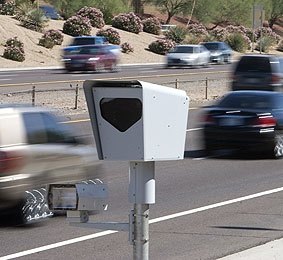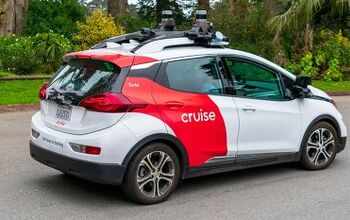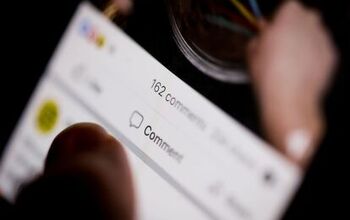AZ Pols Pocket $36,265,795 in Photo Radar Campaign Contributions
A tax levied on speeding tickets funds the re-election efforts of two-thirds of Arizona’s politicians and provides lawmakers with a personal financial incentive to protect controversial photo enforcement programs. In 1999, a ten percent surcharge was imposed on all traffic tickets to create the “Citizens Clean Election Fund.” The fund allows politicians to avoid tedious fundraising efforts. After raising just $5 each from 220 people in a district, candidates for public office qualify for public financing money to match private expenditures. In effect, these lawmakers collect $16.50 for their campaigns each time a photo radar ticket is issued on an Arizona freeway. This adds up to big money. In 2008, traffic tickets generated $10,095,771 in revenue for the clean elections fund.
Out of this amount, $7,710,739 million was disbursed to lawmakers and candidates during the primary and general elections — an average of $72,063 each. In just the past four months, the new freeway speed camera program has already added another $3.3 million to the total amount collected for lawmakers. Over the past four election cycles, Arizona politicians collected a total of $36,265,795 in campaign cash from the tax on speeding tickets. Opponents of the state photo ticketing program are crying foul.
“Photo radar pays for politicians to get elected,” Shawn Dow, a volunteer for the activist group CameraFraud.com, told TheNewspaper. “Voters want the cameras gone but the politicians want them to stay since it pays for their election. This is the reason that the people believe our government is corrupt.”
Dow raised the election funding issue before the state House Transportation and Infrastructure Committee last Thursday while testifying against House Bill 2170. This legislation is portrayed as a repeal of former Governor Janet Napolitano’s freeway photo program, but the text of the proposal actually allows freeway photo ticketing to continue against truckers and other holders of commercial vehicle licenses.
Some of the biggest supporters of photo radar are recipients of significant ticket funding.
“Photo-radar tickets aren’t issued,” state Senator Rebecca Rios (D-Apache Junction) told the Arizona Republic in February 2008. “They’re earned.”
Rios herself earned $35,634 in campaign funds from speeding tickets last year. Other legislators appear less supportive of photo radar by introducing legislation that make minor modifications to the way programs are run.
State Representative John Kavanagh (R-Fountain Hills), for example, introduced House Bill 2722 last year which would have mandated that the profits from any local jurisdiction’s use of a speed camera on a state highway be directed into the Arizona Highway Patrol Fund so that it could be used to fund additional traffic ticketing details. Kavanagh has taken $156,654 in campaign funding from speeding tickets.
The clean elections fund does have other sources of revenue besides traffic tickets. A $5 check-off on income tax forms generated about $6 million which was spent on “voter education” efforts directed by the Citizens Clean Elections Commission. Money left over in the fund from the off-years without elections goes into the general fund.
More by The Newspaper
Latest Car Reviews
Read moreLatest Product Reviews
Read moreRecent Comments
- Dave M. IMO this was the last of the solidly built MBs. Yes, they had the environmentally friendly disintegrating wiring harness, but besides that the mechanicals are pretty solid. I just bought my "forever" car (last new daily driver that'll ease me into retirement), but a 2015-16 E Class sedan is on my bucket list for future purchase. Beautiful design....
- Rochester After years of self-driving being in the news, I still don't understand the psychology behind it. Not only don't I want this, but I find the idea absurd.
- Douglas This timeframe of Mercedes has the self-disintegrating engine wiring harness. Not just the W124, but all of them from the early 90's. Only way to properly fix it is to replace it, which I understand to be difficult to find a new one/do it/pay for. Maybe others have actual experience with doing so and can give better hope. On top of that, it's a NH car with "a little bit of rust", which means to about anyone else in the USA it is probably the rustiest W124 they have ever seen. This is probably a $3000 car on a good day.
- Formula m How many Hyundai and Kia’s do not have the original engine block it left the factory with 10yrs prior?
- 1995 SC I will say that year 29 has been a little spendy on my car (Motor Mounts, Injectors and a Supercharger Service since it had to come off for the injectors, ABS Pump and the tool to cycle the valves to bleed the system, Front Calipers, rear pinion seal, transmission service with a new pan that has a drain, a gaggle of capacitors to fix the ride control module and a replacement amplifier for the stereo. Still needs an exhaust manifold gasket. The front end got serviced in year 28. On the plus side blank cassettes are increasingly easy to find so I have a solid collection of 90 minute playlists.


































Comments
Join the conversation
Wow. And there are people proposing government funded elections on a national level to clean up politics. Should we use Arizona as a model?
[...] yet more money from taxpayers, and to line the pockets of the companies that sell and run them. (And, as always when money and politics are combined, one hand washes the other.) Good riddance to a bad idea, and hopefully more Texas municipalities (Round Rock, I’m [...]